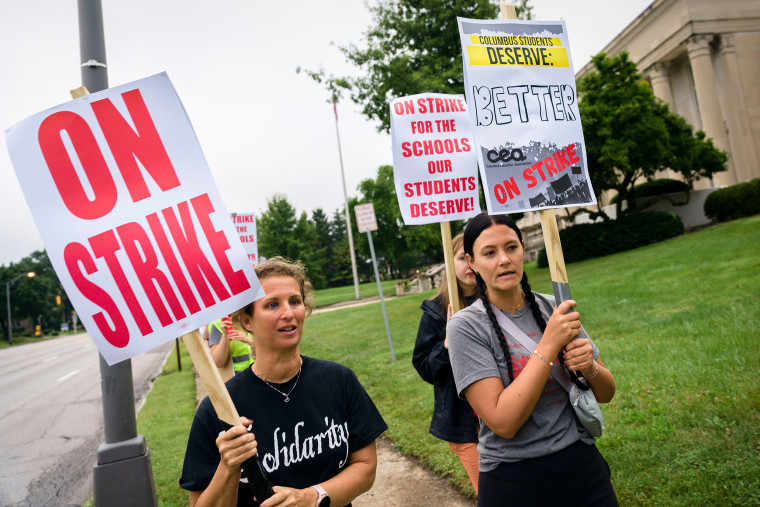Back in the 1990s, the beginning of the academic year at my Brooklyn high school often coincided with a string of extremely hot days. At the start of class, most students clamored for the row of seats closest to the windows rather than the blackboard, as students competed for whatever breeze was available. Teachers kept their classroom doors open in the hope that there’d be cross-ventilation, so their lessons were interrupted by the noise from the hallway. To help alleviate the situation, we were given class time to make paper fans.
Effective teaching and learning don’t take place when teachers and students are physically uncomfortable because of high heat or cold.
Still, everyone sweltered in our barely ventilated and overcrowded space. My skin stuck to my seat, and sweat dripped from my teachers’ hairlines, their shirts damp as they moved about the room to teach. Outside beverages weren’t allowed, so students frequently asked for trips to the water fountains. With teachers constantly having to tend to students’ discomfort (as well as their own), the heat was a predictable disruption to teaching and learning. The curriculum became a mere afterthought as the only question on anyone’s mind was “How long until we get out of here?”
It’s no wonder, then, that teachers in Columbus, Ohio, find themselves striking as school starts up this year. One of the central conflicts between the teachers union and the Columbus City Schools Board of Education is about overheated classrooms, which create an environment the teachers describe as miserable.
As reported in The Columbus Dispatch, several schools that began the year without air conditioning were on track to complete HVAC projects in August, and the school board has told teachers six more buildings will have completed their HVAC projects in mid-to-late September. But NBC affiliate WCMH of Columbus reported that three schools aren’t scheduled to receive this renovation during the 2022-23 school year, though the city has said two will get them next summer.
But the teachers union says this arrangement is unacceptable given the deplorable teaching conditions. Some protesters also claimed to CNN that the school board’s history of vague promises to improve school conditions and the current offer’s lack of specific details were reasons not to take it at its word.
There are perennial education issues at play in the Ohio strike, as well, including demands for appropriate class sizes and full-time art, music and physical education teachers in the city’s elementary schools. But it's preposterous that basic standards for health and safety in schools require collective bargaining to secure, particularly in this post-Covid, changing-climate world. Why are humane teaching conditions still considered negotiable?
There’s a lot at stake. Similar to what the research shows when students arrive at school hungry or sleep-deprived, effective teaching and learning don’t take place when teachers and students are physically uncomfortable because of high heat or cold. According to data compiled by the Illinois Department of Public Health, “Classroom temperatures should be maintained between 68 degrees and 75 degrees Fahrenheit during the winter months and between 73 degrees and 79 degrees Fahrenheit during the summer months.” Those numbers are a far cry from what I experienced during heat waves in Brooklyn, and the sweltering conditions are only getting worse as temperatures skyrocket.
Researchers at Harvard, meanwhile, published data about heat and learning that found that without air conditioning, “each 1°F increase in school temperature reduces the amount learned that year by one percent.” Experts have also found that children “are more susceptible to heat-induced illness than adults” and require special protections from high temperatures.
And yet, a 2020 report published by the U.S. Government Accountability Office says “about half of districts needed to update or replace multiple systems like heating, ventilation, and air conditioning (HVAC) or plumbing” — about 36,000 schools. The report says this figure is a “low-point, conservative estimate.”
Scientists, researchers and public policy experts are beginning to argue that air conditioning should be considered a basic human right amid the climate crisis. But in New York City, outfitting the city’s schools for air conditioning wasn’t much of a priority until 2017, when its mayor at the time, Bill de Blasio, announced his goal of installing air conditioning units in every one of the city’s classrooms by 2022.
Even these belated plans excluded thousands of school spaces, such as gyms and cafeterias — unventilated and overcrowded spaces where students were asked to practice social distancing — according to the education news organization Chalkbeat. As of this time last year, thousands of schools had been cleared for face-to-face instruction despite unreliable ventilation, WNYC/Gothamist reported.
In addition to the pandemic-related concerns that have plagued school environments, the planet continues to get hotter every year, with 2021 being the sixth-warmest year on record, according to the National Oceanic and Atmospheric Administration. And yet, the right for teachers and students to have their basic needs for health and safety met remains controversial.
I understand the frustration many students and parents in Columbus might be feeling right now. A lot of people have a hard time supporting — or even understanding — an event as disruptive as a teachers’ strike. While recent reports suggest that the teachers union and the school board may be on the verge of an agreement, the situation is maddening for all involved, no matter the weather.
But before anyone takes a stand against Columbus’ teachers — or any teacher fighting for reasonable working conditions — I’m compelled to ask for a condition of my own: Spend the day teaching in a hot, overcrowded classroom before deciding that our nation’s teachers are asking too much. Only then would such opinions qualify as informed.
